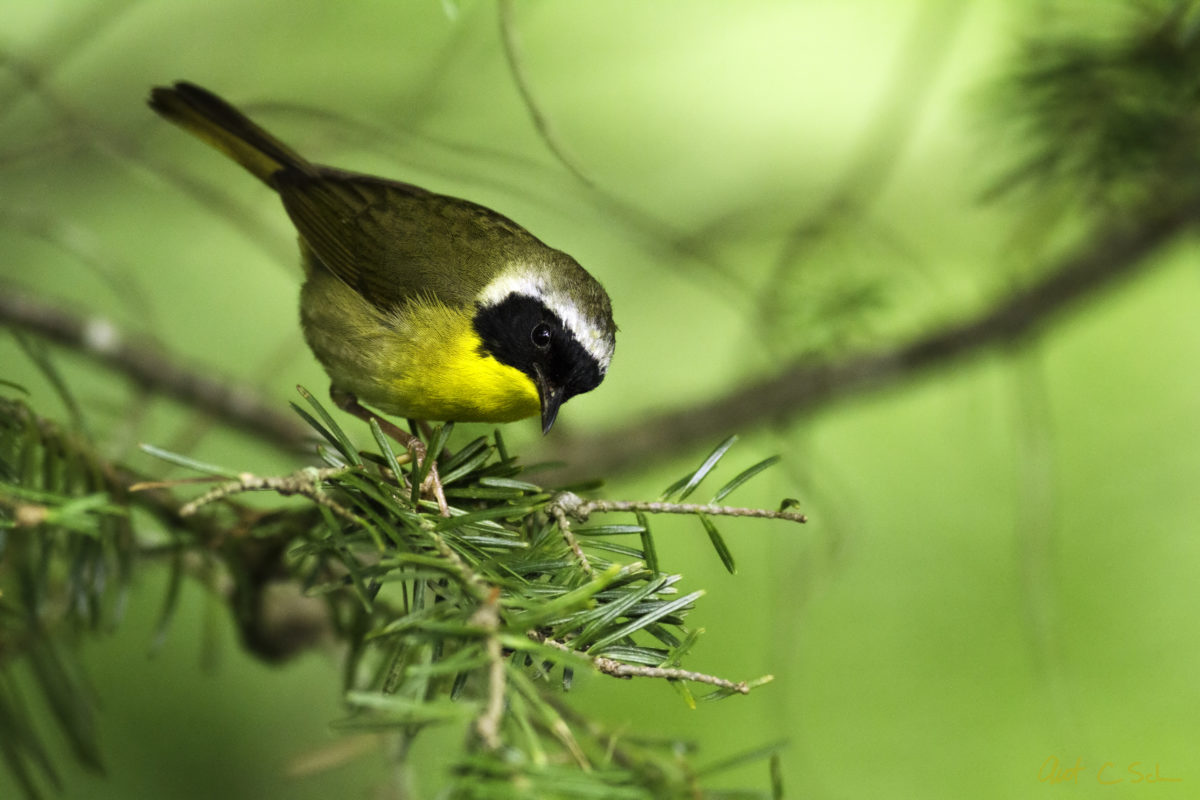Tips to find the most popular and colorful birds in the Northeast
They’re tiny.
They’re colorful.
They’re loud.
They’re often foraging high in the leafiest canopies, making them impossible to see even while bending over backwards.
See below, the Blackburnian Warbler with bright orange throat, notorious for foraging way high up.

Despite the challenges of watching warblers, or perhaps because of them, these birds are among the most anticipated of all the spring arrivals to the northeast.
But how do you find them?!
8 Tips to find 10 Warblers
Tip #1: look in the canopy. Many warblers like to flit and fly in the treetops, so keep your eyes and ears pointed skyward. (Disclaimer: talk to your chiropractor before taking my advice.)
Tip #2: warblers are songbirds. Males bellow a unique tune to mark their territory during breeding season. Learn the codes and you can unlock the secret to finding new and different species of warbler.
What is the best way to find a fire-throated angel, that Blackburnian warbler? Learn its song or play the recording in your ear to jog your memory when you’re in the field. If you hear one in the treetops, sometimes you can follow its foraging through the branches for a better look (but don’t hold your breath).




Tips of Timing
Tip #3: study migration. The best time of year to find warblers is during spring migration, while large numbers stop at (relatively) predictable spots on their way to their breeding grounds.
You’ll notice the highest concentration of birds and the greatest diversity during peak migration. Some species that don’t stay in your area to breed will be passing through during migration, making this window the best for finding new birds.
The timing of migration varies for each species and each year. Some warblers leave their wintering grounds early—Yellow-Rumped Warblers, Palm Warblers—some leave late—Canada Warblers, Wilson’s Warblers. At the same time, each year presents different weather patterns that can impact the overall timing of migrations northward and cause hyper-local fallouts of birds.
But you ask, “how do I know when it’s the right time of year?” Really good question. The best answer: go birding every morning in new locations until you start seeing warblers! An answer for the “work smarter, not harder” folks: check eBird at the hotspots near you to see what other birders find. Usually I use both methods!


If you’re searching for fall warblers, be prepared to find molting, or worn birds, and juveniles with different color patterns than you’d see in the spring.
Tip #4: get up early! Time of day really does make a difference in the number of songbirds singing. It doesn’t have to be the crack of dawn; don’t be discouraged if you fail to wake up before the dew disappears. But you know the saying about the early bird: the later it is, the harder it is to find warblers.
More Tips: Location
Tip #5: Think water. The best songbird and warbler hotspots are near water. These birds love bugs and bugs need water. Even the most obscure and unknown swampy area will be home to warblers during the right time of year—you don’t always have to go to the most popular birding locations.
In my experience, standing water with lots of nice dead snags and low bushes is the best kind of warbler habitat. But don’t be deterred by rushing streams either, some species like the Louisiana Waterthrush love those spots too.


Tip #6: remember ELWO. Edge, Low, Wet, Overcast.
Edge: the best place to find any wildlife is the edge. Where the forest meets the lake, where the meadow meets the river, where the oak grove meets the pine forest.
Low: although you’re taking my advice and looking up into the canopy, don’t discount the low, dense vegetation, especially near streams. Yellowthroats, Canada Warblers, Wilson’s Warblers, and others will take refuge in the low vegetation.


Wet: I can’t say it enough, wet areas are the best!
Overcast: you may not want to go birding if the weather is crummy.
But when the rains come the warblers drop. Remember those species that usually prefer the treetops (Tip #1)? They come down much lower on a rainy day—neither they nor the bugs they’re chasing like to be blown around and rained on.
Personality Tips

Tip #7: listen, listen, listen! Sounds are usually your very best clue for finding warblers (and other birds too). I know I mentioned this in Tip #2, but it’s worth repeating—that’s how important it is to finding warblers.
To better bird by ear, download a guide to your phone that lets you hear birdsong during your walks, use voice memo apps to record sounds you hear in the field, and go birding with friends (and especially experts if you can find them). You can search ” my bird mnemonic” to find catchy phrases that make remembering songs easier. This phase of birding takes so much practice but it will pay off immensely.
Tip #8: be friends with the birds. All species have unique habits and behaviors, often repeated and predictable.
The Ovenbird runs on the ground and sings from a low perch. Black-and-White warblers stalk up tree trunks like jailbreaking nuthatches. And Palm Warblers patiently wag their tail feathers before takeoff.


I hope you can put these tips to the test! Soon you’ll find the warblers you seek and have that much more appreciation for the warmth these birds bring to our fields and forests every year.
Happy spring!
P.S. If you like birds, check out my new fun game, BirdMaster, and my special gallery of bird photography. Cheers.

Let me know what you think: